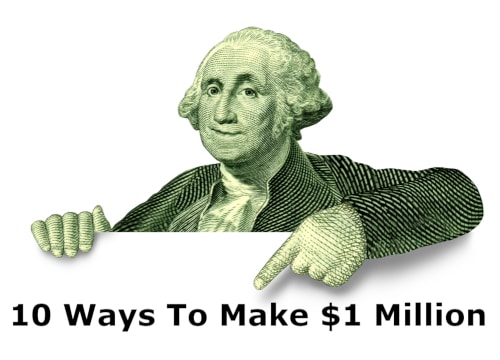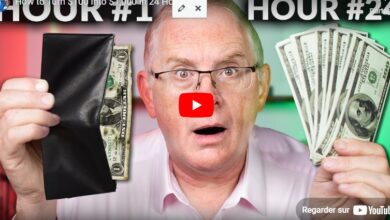10 Ways to Make One Million Dollars (Seriously!)
Having a million dollars may seem like the impossible dream, particularly if you’re starting from zero. But the fact that there are more than 22 million millionaires in the US already means it’s doable. After all, if at least 22 million people can do it, so can you.
All you need are the right strategies and a generous helping of patience, and you can do it too.
To help you in that pursuit, below, I’ve laid out ten ways to make one million dollars. Depending on your current financial situation, and the intensity of your effort, you can reach millionaire status in anywhere from a few years to two or three decades.
How To Make $1 Million Dollars
1. Choose the Right Career
The more money you earn, the more you’ll be able to save and invest. That will make the path toward one million dollars shorter and easier. For example, it will be much easier to save 20% or 30% of a $150,000 salary than it will be with a $75,000 salary.
U.S. News published a list of the top paying jobs in America earlier this year. It should come as no surprise that a disproportionate number of those are in the healthcare field, typically doctors of one type or another.
But I whittled that list down to the top-paying positions that don’t require you to have a medical degree. After all, not everyone is cut out to be a doctor.
Here’s the list, including the average salary for each occupation:
- Petroleum Engineer: $154,780
- IT Manager: $149,730
- Marketing Manager: $145,620
- Financial Manager: $143,530
- Lawyer: $141,890
- Sales Manager: $137,650
- Financial Advisor: $124,140
- Business Operations Manager: $123,460
- Pharmacist: $121,710
- Actuary: $114,850
- Political Scientists: $112,030
- Medical and Health Services Manager: $111,680
These are just examples of careers known to pay high salaries. If you’re not in one now, it’s something to aspire to. And there are plenty of other trade jobs or career fields where you can make six figures, particularly today on the Internet.
Make it a goal, and pursue it like your financial future depends on it – because it really does.
2. Invest Early and Often
A lot of young people don’t invest early, and that’s a big mistake. It’s understandable since so many people in their 20s graduate from college with big student loan debts. Then there’s always the pull to acquire the trappings of your desired lifestyle. First and foremost, that includes a car. And then there’s an apartment and everything you need to fill it. Then there are those life-enriching experiences, like vacations and travel.
It’s fine to put some of your money into each of those. But at the same time, the earlier you begin investing, the more quickly you’ll accumulate wealth. Even if you start with a little bit, you’ll get yourself on track. And just as important, you’ll be getting yourself into the habit of investing regularly.
But let’s spend a moment on the importance of beginning to invest early.
Let’s say you earn $50,000 per year, and you invest 10% of it – $5,000 per year. In a blended portfolio of stocks and bonds, earning an average annual rate of return of 7%, you’ll have just about $1 million by the time you’re 65.
The calculation is incredibly conservative because it assumes your income will remain $50,000 per year for the next 40 years. It will almost certainly increase, and probably dramatically. That means your portfolio at 65 will be much higher. In fact, you might even reach the $1 million mark before you turn 50, especially if your income rises quickly.
The key to investing your way to $1 million is to start early, and to do it each and every year.
Million Dollar Secret:
The More You Devote to Savings and Investing, the Faster You’ll Become a Millionaire
The higher the percentage of your income you can devote to savings and investing, the sooner you’ll be a millionaire.
In the example above, I showed how you could become a millionaire by investing 10% of your income for 40 years. But if you gradually increase that percentage to 15%, 20% and even 30%, the sooner you’ll reach millionaire status.
One proven way to do that is to increase your savings percentage each time you get a pay increase. For example, if you get a 2% pay hike, increase your savings percentage by 1%. That’s how you can turn 10% into 15% in just five years, or 20% in ten years.
Below is a table that provides a clear example of how this might work over time. Assuming an initial savings rate of 10%, the table illustrates how the savings rate can increase to 15% in five years or 20% in ten years, by increasing the savings percentage by 1% for every 2% pay hike.
| Year | Pay Increase (%) | Increase in Savings Rate (%) | Total Savings Rate (%) |
|---|---|---|---|
| 1 | 2 | 1 | 11 |
| 2 | 2 | 1 | 12 |
| 3 | 2 | 1 | 13 |
| 4 | 2 | 1 | 14 |
| 5 | 2 | 1 | 15 |
| 6 | 2 | 1 | 16 |
| 7 | 2 | 1 | 17 |
| 8 | 2 | 1 | 18 |
| 9 | 2 | 1 | 19 |
| 10 | 2 | 1 | 20 |
Aspiring millionaires don’t save and invest like everyone else. No, they go MUCH higher. It’s how so many become millionaires well before reaching retirement age.
3. Emphasize Growth Investments
I just mentioned a portfolio with an average annual rate of return of 7%. That’s based on a portfolio mix of approximately 60% in stocks, and 40% in bonds. But it’s possible to do even better.
The average annual rate of return on stocks has been right around 10% for the past 90 years. While you should include fixed-income investments, like bonds, the largest allocation needs to be in stocks or other high-yield investments if you want to become a millionaire.
A portfolio consisting of 90% stocks and 10% bonds will produce an average annual yield of better than 9%. And it’s strongly recommended when you’re in your 20s, and even your 30s.
The idea is to emphasize growth in your portfolio. Right now, fixed income investments are only paying around 2% per year. You’ll never get rich on that kind of investment. Fixed income investments do add an important safety element to your portfolio. That’s why you need to have them, though you don’t want to have too many.
If you’re not comfortable being too heavily invested in stocks, you can also expand into real estate investment trusts, or REITs. They have an average long-term return of close to 13% going back to 1978. That’s even better than the return on stocks.
Whether you invest primarily in stocks or REITs – or both – you’ll be adding the growth you need to build your portfolio faster over the long-term.
Below is a table that represents various types of growth investments, along with their potential return and level of risk.
| Investment Type | Potential Return (%) | Level of Risk |
|---|---|---|
| Stocks | 7 – 12 | High |
| Bonds | 3 – 5 | Low to Moderate |
| Real Estate | 6 – 9 | Moderate to High |
| Mutual Funds | 5 – 10 | Moderate |
| Exchange-Traded Funds (ETFs) | 4 – 10 | Moderate |
| Commodities | 5 – 12 | High |
| Private Equity | 10 – 25 | Very High |
| High-Yield Bonds | 6 – 8 | Moderate to High |
| Money Market Funds | 1 – 2 | Low |
| Venture Capital | 15 – 30 | Very High |
4. Use Your Employer Sponsored Retirement Plan for All it’s Worth
If you’re not taking full advantage of your employer’s sponsored retirement plan, you’re missing a major opportunity to reach the million-dollar mark. Employer-sponsored plans like 401(k) and 403(b) plans are one of the very best ways to reach millionaire status.
First, you can contribute up to $22,500 per year, or $30,000 if you’re 50 or older. And under plan rules, there’s no percentage of income limit. You can contribute the first $22,500 you earn to your plan. What’s more, the contributions will be tax-deductible, which means the government will be helping you fund your plan.
Meanwhile, the investment income building in the plan will accumulate on a tax-deferred basis. A 10% return on your portfolio will be 10%, rather than 7%, after being reduced for income taxes in a taxable investment account. Over the long-term, that’ll make a huge difference.
But there’s another benefit that makes employer-sponsored retirement plans a must-have, and that’s employer matching contributions.
If your employer will provide a 50% matching contribution on up to a 10% contribution by you, that will add an extra 5% to your plan each year. It’ll increase your total contributions from 10% to 15% each year. Needless to say, your plan will grow 50% faster.
An employer matching contribution is like getting free money because that’s what it is. At a minimum, you should make a personal contribution rate sufficient to produce the maximum employer matching contribution.
5. Buy a House…Or Two or Three

A house is a silent wealth-building machine. Even if you simply live in the house and make the monthly mortgage payments as scheduled, you’ll be building up a tremendous amount of equity.
For example, let’s say you purchase a house for $300,000. The house doesn’t rise in value, but after 30 years, your mortgage is paid in full, and you own the property free and clear. That will add $300,000 to your net worth.
But at least since World War II, a house has been a way to build wealth from two directions: paying down and ultimately paying off the mortgage, and increasing property values.
According to the US Census Bureau, the median price of a new house was $124,400 in the middle of 1994. By July, 2023 the median price reached $415,400. That’s an increase of just over 270% in 25 years.
Based on those numbers, a house you purchase today at $300,000 could be worth $750,000 in 25 years. That single house purchase would get you three-quarters of the way to $1 million all by itself.
6. Start Your Own Side Hustle
If you don’t have the type of job that pays a six-figure income, one important way to work around that limitation is by starting a side business.
There are too many advantages to a side hustle to pass up the opportunity:
- You’ll have a chance to earn additional income.
- The additional earnings can be dedicated specifically to savings and investments, enabling you to build your portfolio faster.
- You can grow a side hustle to the point where it earns more money than your regular job.
- There are tax benefits to a side hustle. You can write off business expenses, and even take advantage of very generous self-employed retirement plans.
Choose a business where you’re knowledgeable, and preferably one you’re passionate about. Remember, the side hustle isn’t providing you with your regular paycheck for living expenses. For that reason, you can choose to do something you actually want to do.
And one thing that almost always happens when you do something you like is that you end up earning more money!
Which is a nice segue into Strategy #7.
7. Parlay Your Side Hustle into a Full-time Business

One of the best ways to become a millionaire is by becoming self-employed on a full-time basis. There are no limits on how much you can earn, and a successful business can often be sold for a large windfall – even millions of dollars.
A lot of people are understandably afraid to start their own business. That makes sense because there are risks involved. The first is that there will be no cash flow when you start. If that continues too long, your business will fail.
But you can avoid that outcome if you start with a side hustle. While you’re still on someone else’s payroll, you can build up your business on the side. You’ll be able to take as much time as you need, and do what’s necessary to make it happen, all without the risks associated with making it a full-time plunge.
Once you reach the point where your side hustle is providing steady cash flow, maybe even something close to being income from your full-time job, it’ll be time to take the leap of faith and make it your full-time venture.
Armed with the knowledge that your business can succeed (because of your side hustle experience), you’ll have the confidence to take your business as far as your talents and effort can.
As a side benefit, special self-employed retirement plans, like the SEP IRA and Solo 401(k) can enable you to contribute up to $66,000 per year.
With tax-sheltered contributions that high, you’ll reach millionaire status in no time at all.
8. Become Friends with Other Millionaires
“You are the average of the five people you spend the most time with.”
Jim Rohn
It’s been said that we’re all the average of our five closest friends. If at least one or two of your friends are already millionaires, you’ll have a better chance of joining them.
That’s because you’ll learn how they think and act, particularly toward money. And just knowing such people can be motivating. When you get to know and become friends with real people who are millionaires, you begin to realize the goal is doable.
What’s more, you can turn to your millionaire friend(s) for advice. And because they’re already there, you can trust you’ll be getting the right advice. There may even be times where you’ll be able to participate in wealth building opportunities simply because of the connections your millionaire friend(s) have.
If you don’t know any millionaires personally, make it a point to begin following some on the web. There are many, many highly successful people telling their stories on blogs and YouTube.
Find a few you like and follow them regularly. And by swapping emails, you might just find a real millionaire friend. It’ll be well worth the effort.
9. Avoid “Lifestyle Inflation”
Lifestyle inflation is what happens as your income and wealth rise. While that may seem like a natural progression, it actually hurts your chances of becoming a millionaire. While your income and investments are rising in value, your lifestyle is eating up an increasing percentage of both.
Lifestyle inflation is especially common with a rising income. As your income grows, you suddenly find yourself “outgrowing” your house, your car, the vacations you take, and the restaurants you frequent. You may also be tempted to join a country club, or take on expensive hobbies.
But if you want to become a millionaire in the shortest time frame possible, you’ll need to avoid going in that direction. At best, it will slow you down, and at worst, it may lend you in bankruptcy court.
Wants turn into needs, and before you know it, you don’t know where your money is going.
If you spend any time studying people in the FIRE movement – which is a moniker for Financial Independence, Retire Early – they do the exact opposite. As their incomes grow, they keep their living expenses fixed, and expand the portion of their earnings that go into savings and investments.
If you hope to join the million-dollar club, you’ll need to do the same. And that’ll require, first and foremost, avoiding lifestyle inflation.
Translation: live as far beneath your means as possible. There will be plenty of time to enjoy the good things in life once you’re a millionaire. But you’ll have to work on getting there first.
10. Stay Out of Debt
If you buy or own a house, you’ll almost certainly have a mortgage. It’s also very typical to have a loan on a new or late model car. And millions of students graduate college with student loan debts.
If you have any of those debts, you should make it a personal mission to pay them off as soon as possible. You’ll not only get out of debt, but you’ll free up your cash flow to save and invest more money.
Why you’re paying off those necessary debts, it is also vitally important that you avoid other types of consumer debt. These can include installment debt for the purchase of furniture and similar items, timeshares, and especially credit cards. Each not only adds to your debt burden, but they usually carry very high interest rates.
For example, if you’re paying 20% on a credit card balance, you’re not likely to get anything close to that in investment returns, at least not on a long-term basis.
Paying off that kind of debt and avoiding it in the first place is the best way to take control of your income. The less debt obligation you have, the quicker the path to $1 million will be.
The Bottom Line: Make One Million Dollars In Just A Few Years
If you’re able to use all 10 of the above strategies, you’ll likely become a millionaire in just a few years. But even if you choose to focus on only three or four, you’re highly likely to reach millionaire status at least at some point in your life.
You can choose the fast track or the slower one – it’s up to you.
FAQs – Making One Million Dollars
Common mistakes in learning how to make one million dollars include lacking a clear plan, taking on excessive debt or risk, investing in something without proper understanding, failing to diversify investments, and neglecting tax and legal considerations. Avoiding these can increase the likelihood of success.
To learn how to make one million dollars through investment, consider diversifying across various assets like stocks, bonds, real estate, and mutual funds. A long-term, disciplined approach, reinvesting dividends, and working with a financial advisor can help you reach this goal.
Yes, investing in real estate is a common strategy on how to make one million dollars. Through buying, improving, renting, or selling properties, one can build substantial wealth. Leveraging mortgages, tax benefits, and market appreciation can accelerate the process.
While there may be opportunities that promise a quick way on how to make one million dollars, such as high-risk investments or speculative business ventures, they often come with significant risks and uncertainties. Losing the entire investment is possible, so careful consideration and due diligence are essential.
For an individual with an average income planning on how to make one million dollars for retirement, consistency is key. Contributing regularly to retirement accounts, taking advantage of employer-matching programs, investing wisely, reducing unnecessary expenses, and seeking professional financial guidance can make the goal attainable.






